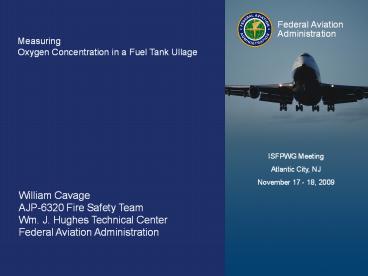Measuring - PowerPoint PPT Presentation
Title:
Measuring
Description:
Made design changes to OBOAS regulated sample train and packaging based on ... New system is lighter, smaller, quieter, and takes less power to start and operate ... – PowerPoint PPT presentation
Number of Views:23
Avg rating:3.0/5.0
Title: Measuring
1
Measuring Oxygen Concentration in a Fuel Tank
Ullage
ISFPWG Meeting Atlantic City, NJ November 17 -
18, 2009
William CavageAJP-6320 Fire Safety TeamWm. J.
Hughes Technical CenterFederal Aviation
Administration
2
Outline
- Background
- FAA Method
- Light Absorption Gas Sample
- Optical Fluorescence In Situ
- Status
3
Background
- FAA has been seeking to improve fuel tank safety
in the wake of TWA Flight 800 in July of 1996 - Rule published requiring extensive flammability
reduction on both future built and existing
aircraft on present types - The measurement of ullage oxygen concentration is
important to the fuel tank inerting community
when researching methods, validating models, and
certifying systems - FAA method for measuring ullage oxygen
concentration at reduced ullage pressures has
been successful but can be cumbersome - Emerging products have the potential to simplify
and improve upon RD / Certification work for
fuel tank inerting
4
FAA Method
- FAA method involves an extensive controlled gas
sample system using lab based galvanic cell
oxygen sensors - Method used extensively in the lab and on several
flight tests with great success - Consistently duplicates calibrations gases up to
40K feet within /- 0.1 oxygen - Improved FAA gas sampling method
- Made design changes to OBOAS regulated sample
train and packaging based on lessons learned
during FAA flight testing - New system is lighter, smaller, quieter, and
takes less power to start and operate - Gas sample lag time better but not proven to have
equivalent level of safety - Questions remains if it is more reliable and
maintainable
5
FAA Oxygen Concentration Measurement Method
6
FAA Method Flight Test Results Compared with Lab
and Analytical Calculation
7
4-Bay Cascading Inerting Data Comparison of FAA
Method Compared with Analytical Calculation
8
Light Absorption Gas Sample
- Oxigraf makes a light absorption sensor which has
been applied to an unregulated gas sample train - Unregulated sample train uses an integrated
sensor board that measures infrared light
absorption using a tunable laser diode (TLD
technology) - Proprietary software used to interpret spectral
data - System has been packaged for flight test
- System has very fast response time, given short
enough gas sample lines and has been shown to
duplicate calibration gases as well as FAA method
up to 35K feet sample altitude. - System packaging has potential to be
significantly smaller and lighter than the FAA
method and system requires less power. - System speed has yet to illustrate usefulness and
there are significant limitations to gas sample,
and return locations
9
Light Absorption Method using TLD
Oxigraf O2N2 Flight TestOxygen Analyzer
10
Results Airplane Fuel Tank Simulation
- Measured fuel tank test article ullage O2 with
both the FAA method and the light absorption
method (Oxigraf)
- Results of Oxigraf and FAA method very close
- The inerting of test tank erratic due to
problems, but this illustrates the small
advantage of rapid response
11
Optical Fluorescence
- Optical fluorescence using in situ probe (ASF)
- Small fiber optic probe uses spectrometer to
interpret coherent light signal which is highly
dependent on temperature/pressure - Used in situ (in place) which has many advantages
(low power, small size/weight, rapid response)
but also has limitations - Applying an in situ probe has been be very
problematic - Not practical to calibrate on a daily basis
- Requires simultaneous/co-located accurate
temperature and pressure measurement to
compensate signal - As applied today, does not have faster response
than FAA - Recent work performed has illustrated marked
improvement of the probe to duplicate calibration
gases - Still struggle with good results at high
altitudes - Probe has passed rigorous DO-160 E testing
12
Latest Optical Fluorescence (ASF) In Situ Probe
13
ASF Oxygen Sensor Data with Varying Temperature
14
Status
- Both the FAA method and the light absorption
(Oxigraf) method duplicate calibration gases well
at a variety of conditions and both agree on
oxygen concentration measurements made during a
simulation of an inert commercial transport
airplane fuel tank flight cycle - Oxigraf system has faster response time but
appears to be of little advantage - Oxigraf system already performed some flight
testing and is slated for more with several OEMs
/ Operators - Optical fluorescence making progress but still
working out problems - Slated for more chamber examinations in December































